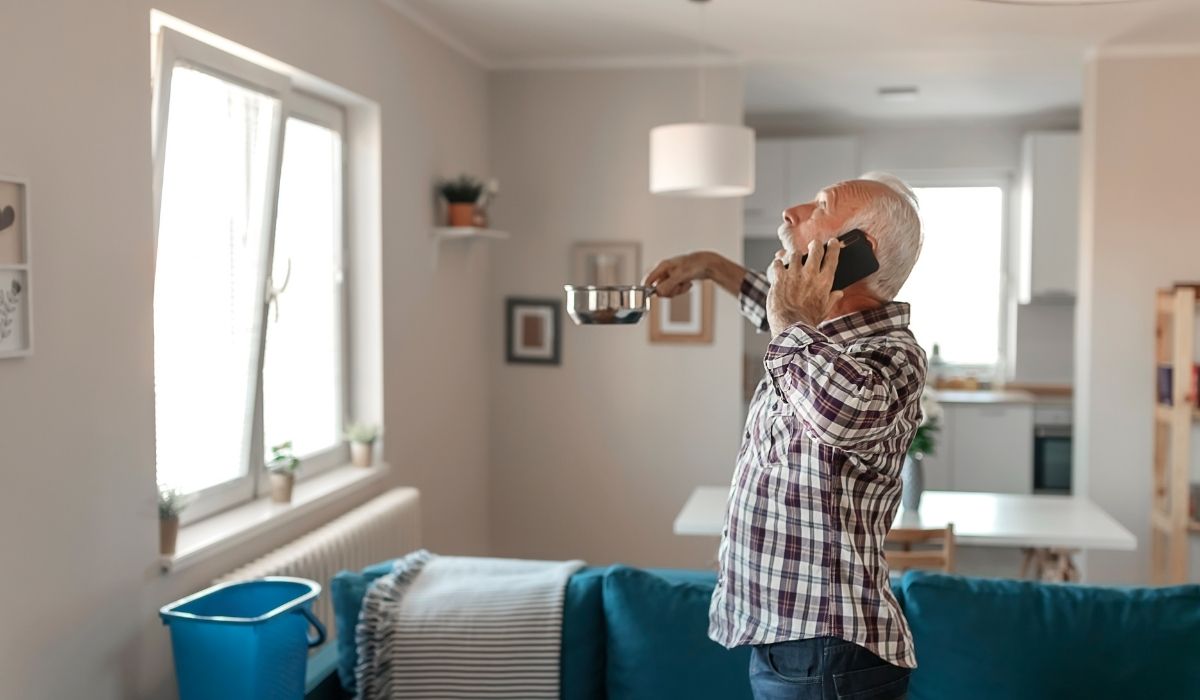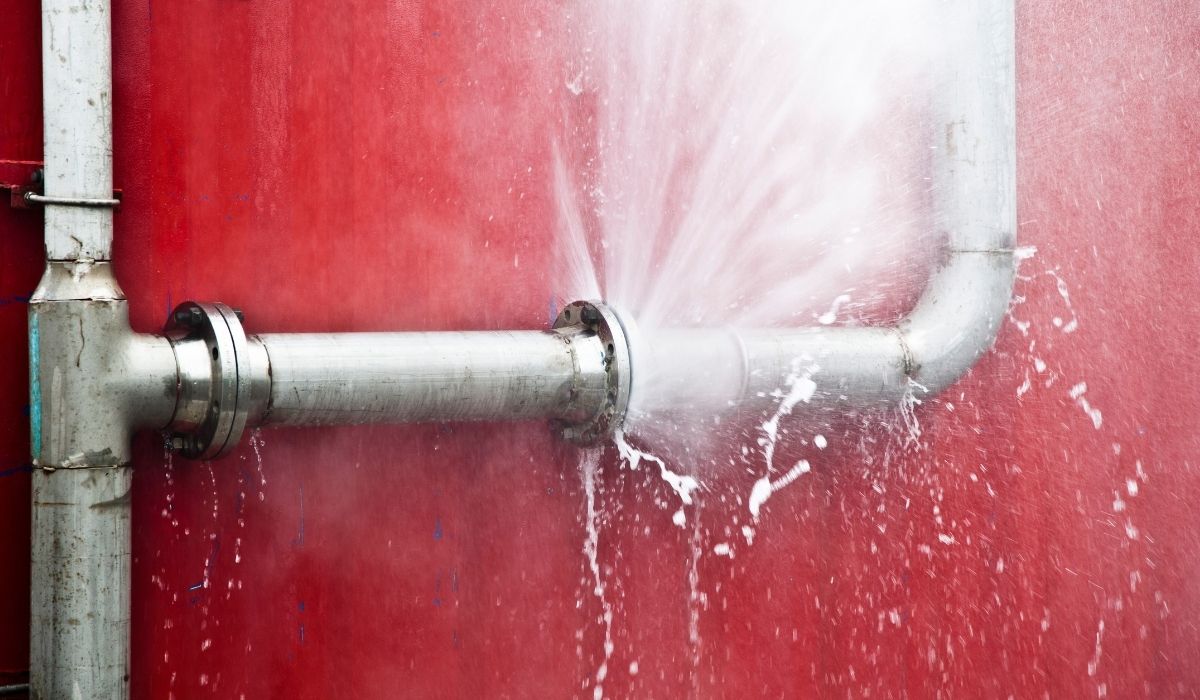Understanding Kitchen Water Damage Restoration and Its Solutions

Kitchen Water Damage Restoration: Common Causes & Solutions
The kitchen is often considered the heart of a home, a space where meals are prepared, and families gather. However, it is also one of the most vulnerable areas to water damage. Problems such as leaking pipes, appliance malfunctions, and faulty fixtures can lead to significant damage if not addressed promptly. Water damage in the kitchen can result in issues ranging from structural deterioration and mold growth to ruined cabinetry, flooring, and electrical hazards. Identifying the sources of these incidents is crucial for timely restoration and to prevent additional losses. Homeowners may also face complications with insurance claims when water damage occurs due to common faults like a leaky dishwasher or poor ventilation. This article explains common causes, immediate steps for cleanup, repair processes, and prevention methods specific to kitchen water damage. It offers actionable remedies so that homeowners can restore their kitchens and protect their investments. Let’s explore the spectrum of issues and practical solutions behind kitchen water damage restoration.
Transitioning to the details, the article will break down the most frequent causes of water incidents, address efficient cleanup procedures, outline repair methods, focus on dishwasher-specific issues, provide restoration tips, and finish with preventive measures to help mitigate future risks.
Identifying Common Sources of Kitchen Water Incidents
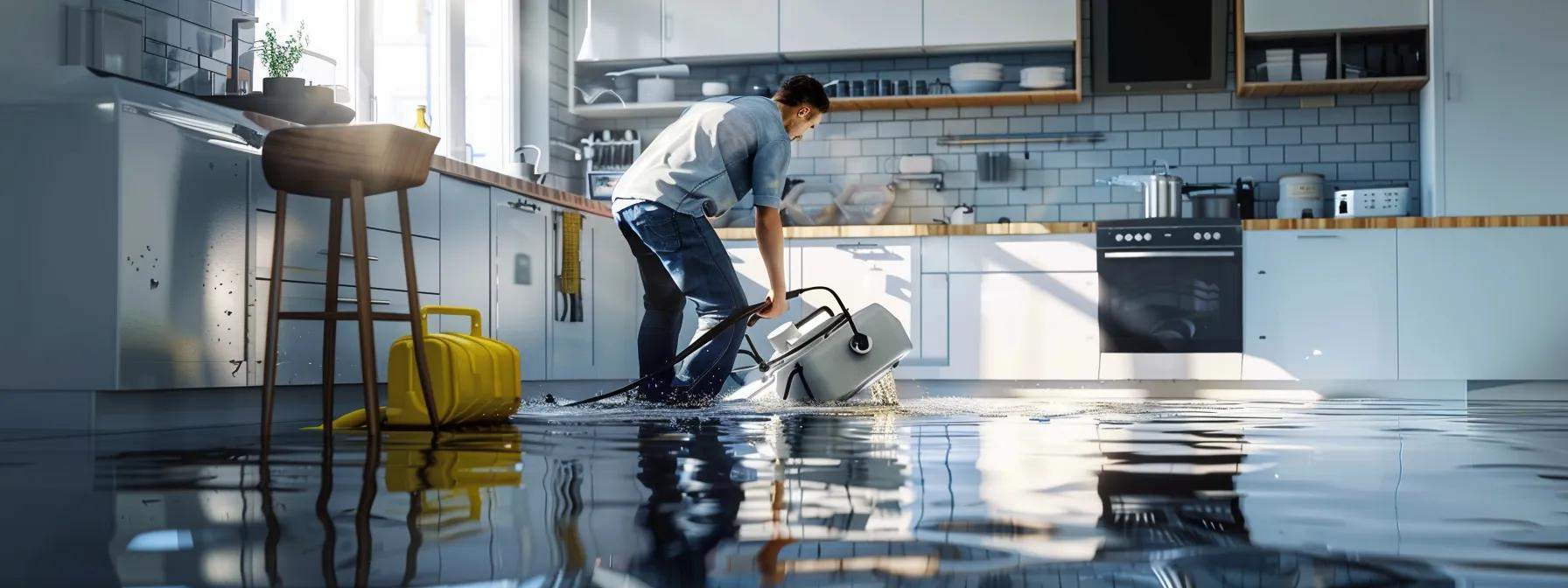
In any kitchen, water damage events typically originate from several common sources. The first source is hidden pipe leaks that may manifest as damp stains or unusual odors. These leaks can be a result of corrosion or physical damage to copper versus galvanized pipes. Next, appliance malfunctions, such as those involving the dishwasher or refrigerator ice maker lines, often cause water spills that infiltrate cabinets and flooring. Additionally, sink overflows and faulty faucet connections are responsible for flooding localized areas, particularly when the water supply is interrupted by a weak valve seat. Another frequent contributor is the failure of the refrigerator’s ice maker line, which can leak slowly over time, causing significant damage without immediate notice. Lastly, a dishwasher leak can be particularly destructive if not promptly detected, as it can seep into cabinetry, surrounding insulation, and consumer electronics stored in or near the kitchen.
Recognizing Signs of Hidden Pipe Leaks
Homeowners should remain vigilant for subtle signs of hidden pipe leaks. These include damp patches beneath the sink, discoloration or bubbling on ceiling surfaces, and a persistent musty odor. A water stain on the wall that appears even when there is no obvious reason can signify a hidden leak in the concealed pipes behind the cabinetry. Such signs may also include an unexplained spike in the water bill or an inability to fully dry the area around plumbing fixtures. In many cases, these leaks are chronic issues that slowly degrade the integrity of the structure, leading to costly repairs if undetected. Using a moisture meter for inspection and scheduling periodic repairs can help detect these early indicators.
Appliance Malfunctions Leading to Water Spills
Major kitchen appliances, such as dishwashers, refrigerators, and washing machines, often come with complex water supply lines and drainage systems. When these connections fail, leaks and spills may occur. For example, a faulty door seal on a dishwasher can cause water to seep out onto the floor, while a malfunction in the refrigerator’s ice maker might result in an overflow. These malfunctions can stem from mechanical wear, poor installation practices, or even manufacturing defects. It is important to inspect these appliances regularly for signs of deterioration, corrosion, or damage to hoses and seals. Professional servicing on a scheduled basis not only prevents damage but also prolongs the life of the appliance. The cost of timely service far outweighs the expenses incurred from extensive water damage restoration.
Sink Overflows and Faucet Issues
Regular use combined with the natural aging of faucets predisposes them to issues such as drips, leaks, or even sudden overflows. A minor drip might seem inconsequential, but over time it can culminate in significant water damage. Corroded or worn out O-rings in the faucet assembly may lead to continual drips that saturate the countertop, under-sink cabinetry, and even the floor. Sink overflows occur when blockages in the drain or debris accumulation force water to back up, sometimes spreading over adjacent floors. Proactive maintenance, such as cleaning sink strainers and replacing deteriorated parts, can minimize these risks. Moreover, routine inspection of sink structures helps identify the early onset of corrosion or wear that might otherwise lead to a disaster.
Refrigerator Ice Maker Line Problems
Refrigerators with built-in ice makers are generally designed for convenience, yet they can be problematic if the water supply line becomes kinked, cracked, or improperly installed. These issues may not immediately register, as the leak can be slow and intermittent – just enough for water to seep into insulation and cabinet interiors without obvious signs. Over time, the accumulated moisture creates an ideal environment for mold and mildew, compromising both health and property. Regularly checking the line for visible damage and ensuring proper insulation and secure installation can mitigate these risks, preserving the functionality of the refrigerator while protecting the kitchen from inadvertent water damage.
Understanding How a Dishwasher Leak Causes Damage
Dishwasher leaks are perhaps one of the most frequently encountered issues in kitchen water damage incidents. Water can escape from the unit due to faulty gaskets, blockages in the drainage system, or loose hose connections. The consequences of a dishwasher leak can be severe since water may pool beneath the appliance and infiltrate surrounding cabinetry, flooring, and even electrical installations. This not only explains structural water damage but can also contribute to the development of mold—a serious health hazard. Recognizing recurring patterns such as damp odors, pooled water under the unit, or degraded cabinet materials is paramount. Addressing these symptoms swiftly by replacing worn seals or cleaning clogged filter systems minimizes further damage and ensures that the appliance operates safely.
Key Takeaways: – Hidden pipe leaks often show subtle signs such as water stains and odors. – Appliance malfunctions, including dishwasher and refrigerator issues, are common and require regular maintenance. – Sink overflows and faulty faucets may lead to cumulative water damage if not addressed. – Refrigerator ice maker line issues contribute to mold risks due to gradual leakage. – Dishwasher leaks can severely damage cabinetry and flooring if unattended.
Immediate Steps for Effective Kitchen Flood Cleanup

When water damage occurs in the kitchen, immediate cleanup is vital to minimize long-term structural and health hazards. The first step is to safely shut off both water and electrical supplies. This precaution prevents additional flooding or electrical shock risk. It is crucial to locate the main water valve and the kitchen circuit breakers. Timely action in this phase stops the source of contamination from expanding to other parts of the house. In kitchens where appliance leakage occurs due to a faulty dishwasher, quickly disconnecting the unit from the power and water sources can avert further damage.
Safely Shutting Off Water and Electrical Supplies
Shutting off water and electrical systems is the first response. For water, homeowners should identify and turn off the main valve feeding the kitchen’s plumbing. For electricity, locate the circuit breaker and cut power supply, reducing the risk of electrocution when cleaning wet surfaces. This step must be performed quickly and safely, particularly if the floor is flooded or if water has seeped into areas housing electrical components. Professionals advise that if the water is contaminated or if there is visible exposure to electrical wiring, it is safest to evacuate and call emergency services. This approach ensures that further damage and dangerous accidents are prevented.
Removing Standing Water From Kitchen Floors
After securing the utilities, the next urgent task is to remove standing water from kitchen floors. Using a wet/dry vacuum or mop and bucket is effective in this process. Removal of stagnant water decreases the chance of slip-and-fall accidents and begins the drying process essential for preventing mold growth. In cases involving large water spills, industrial-grade pumps might be necessary. Homeowners should start by extracting as much water as possible, then let the area air-dry with the help of portable dehumidifiers or fans. Removing excess water also prevents further seepage into subflooring and undermining of structural integrity. Documenting the water extraction process is also useful for insurance claims.
Initiating the Drying Process for Affected Areas
Initiating the drying process should begin within minutes of water extraction. Air circulation is key in this phase. Opening windows, using floor fans, and deploying dehumidifiers help accelerate evaporation, reducing moisture levels below thresholds that promote mold growth. In cases where water has penetrated deeply into walls, under floorboards, or cabinetry, additional professional drying equipment might be necessary. The time required for complete drying can vary from a few days to several weeks, depending on the extent of the damage. Using moisture meters can aid in monitoring the progress of drying and confirming that residual moisture levels have decreased to safe levels.
Protecting Furniture and Belongings From Further Harm
While the area is being dried, it is equally important to protect furniture, unsecured appliances, and personal belongings from further damage. Moving items away from the wet area or covering them with waterproof tarps minimizes secondary damage. For items that are embedded in structures, such as built-in cabinetry, precautions such as applying absorbent materials and keeping the doors open can help in reducing moisture retention that might lead to warping or mold infestation. These efforts also facilitate a smoother restoration process as fewer items require replacement or professional cleaning.
Documenting Damage for Insurance Claims
Finally, comprehensive documentation is critical for pursuing insurance claims. Homeowners should photograph or video the affected areas and record the extent of the damage, including any compromised cabinetry, flooring, or appliances. Detailed notes on the sequence of events, the time of the incident, and the immediate measures taken provide valuable context when filing claims. This documentation not only supports the claim process but may also be required by restoration professionals for accurate assessment. Keeping records ensures that the homeowner has all necessary evidence should disputes arise with insurance companies over fault or extent of damage.
Key Takeaways: – Immediately shut off water and electrical supplies to mitigate risk. – Use wet/dry vacuums, mops, and dehumidifiers to remove and dry out standing water. – Ensure proper ventilation to accelerate drying and prevent mold growth. – Protect furniture and valuables during the cleanup process. – Thoroughly document damage for insurance claims with photos and detailed notes.
The Process of Kitchen Water Leak Repair and Damage Mitigation
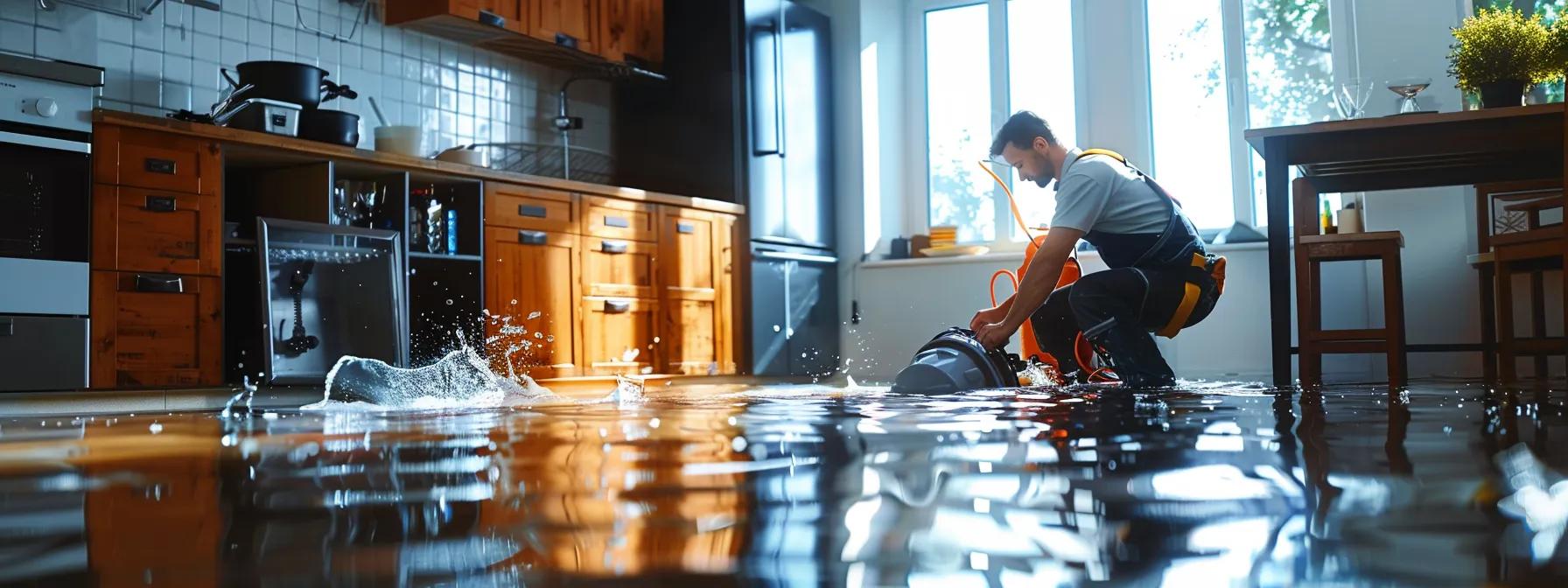
Repairing the source of kitchen water leaks requires a methodical approach to ensure that both the visible and hidden damages are addressed. The repair process begins with a thorough investigation to locate the exact source of the leak. Once identified, appropriate professional techniques are implemented to repair the issue and prevent recurrence. Throughout the process, damage mitigation strategies are employed to safeguard structural integrity and prevent secondary problems such as mold or electrical hazards. This section covers the step-by-step process of diagnosing, repairing, and mitigating further damage from kitchen water leaks.
Locating the Exact Source of the Water Leak
Finding the exact source of leakage is critical. This may involve inspecting pipe connections, faucet assemblies, and the internal workings of appliances. Tools such as moisture meters, thermal imaging cameras, and acoustic leak detectors help determine the hidden leak points. For example, water stains on the ceiling or persistent damp spots under cabinets could indicate leaks behind walls or under floors. Professionals often follow the water trail to pinpoint areas where moisture accumulates, and then use specialized equipment to determine the leak’s origin. Accurate identification not only informs the repair process but also prevents repeated failures, ensuring that all contributing factors are addressed.
Professional Techniques for Kitchen Water Leak Repair
Once identified, professional repair techniques are employed. This can include tightening or replacing hose connections, applying epoxy putty, or even cutting out sections of wet drywall for replacement. In cases where the water damage is extensive, demolition of affected areas may be necessary, followed by reinforcement with new materials such as waterproof backer board or moisture-resistant insulation. Techniques such as using high-quality sealants on seams and joints ensure that the repair withstands everyday use. Certified plumbing professionals might also replace corroded copper pipes with more durable alternatives, like PEX piping, to minimize the chance of future leaks. Using specialized tools and employing skilled labor directly improves the longevity of the restored area.
Assessing the Extent of Structural Damage
Water leaks seldom affect only a single surface. The spread of moisture can compromise the foundation, subfloors, and surrounding cabinetry. Once the leak is fixed, a detailed assessment of structural damage is necessary. Evaluating the integrity of the flooring, walls, and even the understructure becomes critical in determining whether repairs or replacements are required. For instance, persistent moisture exposure may lead to moisture-related expansion in wood, causing warping or degradation. In severe cases, remediation might require the entire section of flooring to be replaced and the subfloor treated for mold prevention. A comprehensive professional assessment ensures that hidden damages are revealed and properly mitigated before concluding the repair process.
Mold Prevention Strategies Post-Leak
Even after the mechanical repairs are complete, the possibility of mold growth remains an ongoing threat if moisture isn’t fully eliminated. Mold prevention involves deep cleaning of all affected areas, application of antimicrobials, and continuous monitoring of humidity levels. Studies, such as one published in the Journal of Environmental Health (Smith et al., 2021; https://www.journalofenvhealth.com/mold), have shown that maintaining indoor humidity below 50% significantly reduces mold spore proliferation. Homeowners are advised to install dehumidifiers and ensure adequate ventilation to promote drying. Effective mold prevention not only protects the structural integrity of a kitchen but preserves air quality and minimizes potential health risks associated with mold spores.
Repairing or Replacing Damaged Cabinetry and Flooring
The final phase of mitigating kitchen water damage involves addressing affected cabinetry, flooring, and other interior finishes. Depending on the severity, damaged cabinets might be repaired with wood fillers and refinished, or entirely replaced. Likewise, flooring solutions vary from tile replacement to installing moisture-resistant vinyl or engineered wood. Using materials designed to resist further moisture intrusion, such as treated or pressure-resistant wood products, is crucial to prevent future incidents. Professional restoration services may also seal the repaired surfaces with protective coatings, ensuring longevity and an improved resistance against water penetration. These restoration measures help return the kitchen to its pre-damage condition seamlessly.
Key Takeaways: – Locating the leak with specialized tools ensures accurate diagnosis. – Professional repair techniques include re-sealing joints, replacing pipes, and removing affected drywall. – Structural assessments reveal hidden damages that require immediate attention. – Effective mold prevention, supported by dehumidifiers and proper ventilation, is critical. – Restoration of cabinets and flooring requires durable, moisture-resistant materials.
Addressing Dishwasher Leak Damage and Prevention
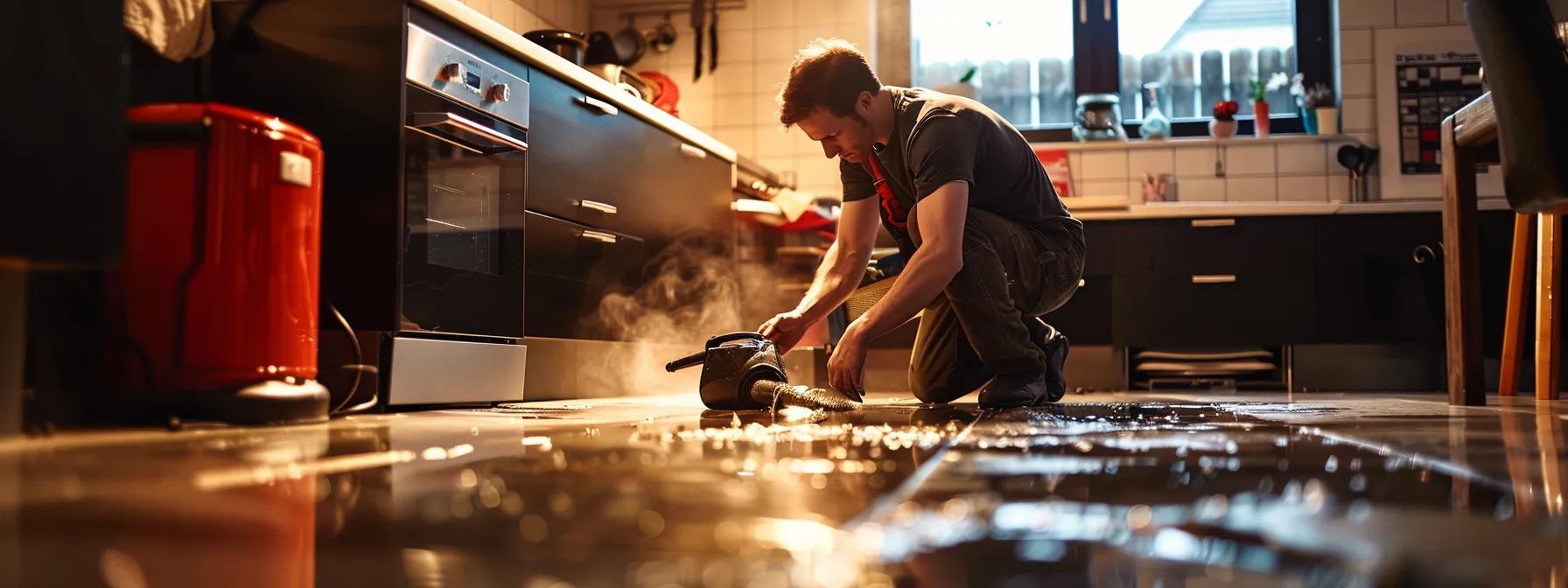
A leaking dishwasher is a common kitchen water damage hazard that can lead to widespread issues if not addressed promptly. Given that dishwashers operate using significant amounts of water under pressure, the consequences of a leak may include damaged cabinetry, warped floors, and even electrical hazards. Understanding the root cause of a dishwasher leak and knowing the necessary repair options can save homeowners both time and money. This section explains the common reasons behind dishwasher leaks, outlines the steps to be taken once a leak is discovered, and offers prevention techniques to avoid recurring incidents.
Common Reasons Your Dishwasher Might Leak
Several factors can contribute to a dishwasher leak. One common reason is a worn or defective door gasket that fails to create a tight seal, allowing water to escape during cycles. Over time, the gasket’s elasticity can diminish due to constant exposure to detergent and hot water, resulting in cracks or loose seals. Another frequent culprit is a clogged or damaged drain pump which hinders the proper discharge of water. Additionally, a disconnected or loose water inlet hose can result in surplus water overflowing onto the floor. Moreover, built-up debris in the filter or bottom of the dishwasher may prevent effective water circulation, leading to leaks. Understanding these factors enables homeowners to perform regular maintenance and preemptively address issues.
Steps to Take When You Find Dishwasher Leak Damage
When a dishwasher leak is identified, immediate action is required to prevent further damage. First, discontinue operation and unplug the appliance from its power source. Then, carefully inspect the area to determine the leak’s extent, focusing on the bottom of the unit, the surrounding cabinetry, and the floor area. Any water present should be promptly removed using a wet/dry vacuum or mop. Next, inspect the hoses, gaskets, and fittings for any visible signs of wear, corrosion, or blockage. Document the damage with photographs and notes for insurance and repair purposes. Engaging a professional plumber may be necessary if the leak is complex or if internal components need repair or replacement. Prompt intervention minimizes moisture retention that can lead to mold growth and structural damage.
Repair Options for a Leaking Dishwasher
Repairing a leaking dishwasher depends on the source of the problem. In many cases, replacing a defective door gasket is a straightforward DIY task. Homeowners can purchase replacement gaskets from hardware stores and install them following manufacturer instructions. For issues involving drain pump malfunction or hose disconnections, professional repair is often recommended to avoid improper installation. In scenarios where internal components have been affected by continuous leakage, a comprehensive evaluation by a service technician is essential. Sometimes, the solution may involve a partial disassembly of the appliance to replace internal sealants or to clear clogged filters. Thoroughly drying and cleaning the affected area prior to repair is critical for effective restoration and to avoid residual damage.
Preventing Future Dishwasher Water Incidents
Long-term prevention of dishwasher leaks focuses on routine maintenance practices and timely repairs. Regular inspection and cleaning of the door gasket, filters, and hoses are essential steps. Manufacturers recommend running an empty cleaning cycle periodically using dishwasher-safe cleaning agents to remove debris buildup. Additionally, it is beneficial to replace parts showing early signs of wear before a critical failure occurs. Investing in an appliance leak detection sensor near the dishwasher can alert homeowners to early leaks, enabling prompt action. Maintaining optimal water pressure and ensuring that the dishwasher is level also contributes significantly to preventing recurring leak incidents. Such proactive measures help extend the lifespan of the appliance and reduce repair costs.
What to Do About Warped Floors From Dishwasher Leaks
Warped floors are a serious consequence of prolonged water exposure from a leaking dishwasher. When floors become warped, it indicates that moisture has seeped into the subfloor materials, causing them to swell and lose their structural integrity. In such instances, professional assessment is necessary to determine whether the flooring can be salvaged or must be replaced. Remediation typically involves drying out the affected area with industrial dehumidifiers, followed by potential replacement of damaged subfloor sections. Sealing the new flooring with moisture-resistant coatings further prevents future damage. Homeowners should also check for any residual mold growth that could compromise the health of the household. Early intervention minimizes the extent of floor damage and reduces the long-term cost of repairs.
Key Takeaways: – Common dishwasher leaks result from faulty gaskets, clogged pumps, and loose hoses. – Immediate action involves shutting off power, removing standing water, and thorough inspection. – Repair options vary from replacing simple parts to engaging professional technicians. – Preventative maintenance, including regular cleaning and leak detection, is key. – Warped floors require professional remediation and may involve subfloor replacement.
Restoring Your Kitchen After Water Damage
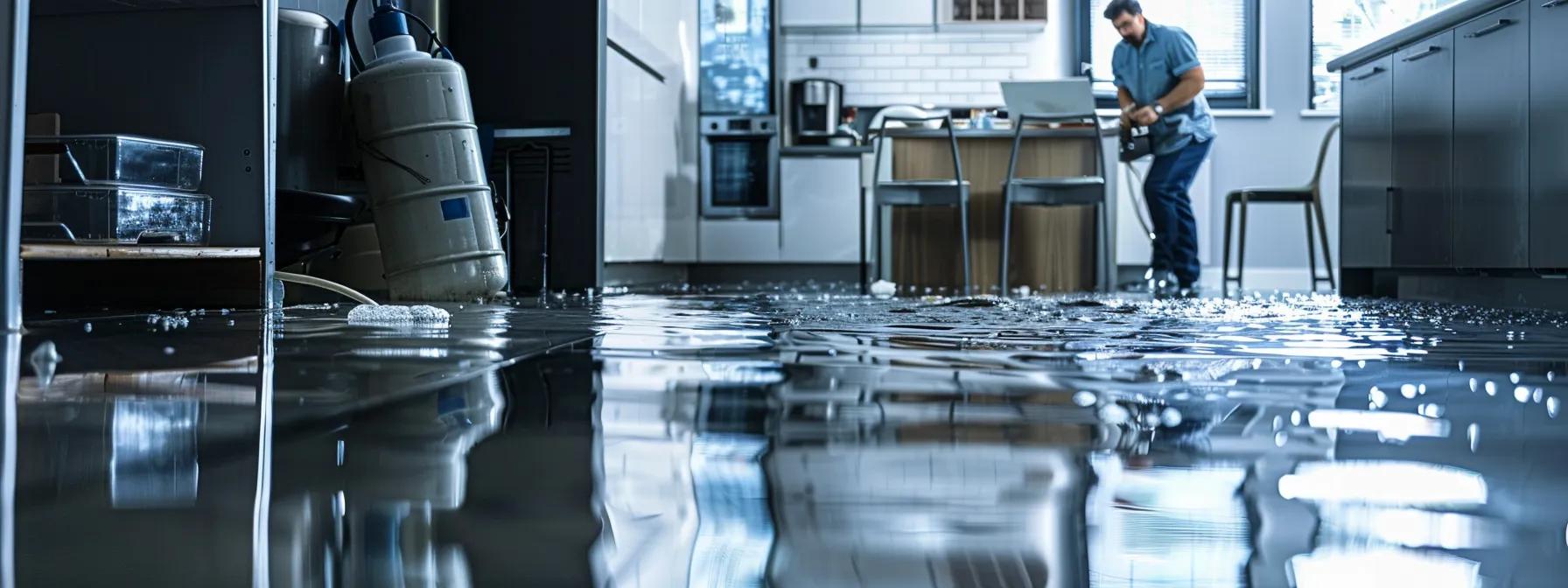
After addressing and repairing the source of water intrusion, restoring the kitchen to its original condition involves several thorough steps. Restoration not only encompasses cleaning and drying the area but also repairing structures, sanitizing surfaces, and restoring aesthetics. The process is crucial to return the kitchen to a safe and functional state while preventing long-term health risks such as mold proliferation. With water damage restoration, the focus is on efficient drying techniques, careful cleaning, and the replacement or repair of damaged materials. Preferred Restoration Services typically employs advanced equipment and expert technicians to expedite recovery while minimizing the loss of personal belongings and structural integrity.
Structural Drying and Dehumidification Techniques
Structural drying begins with the removal of any remaining moisture from walls, cabinets, and flooring. High-powered dehumidifiers and industrial-grade air movers are deployed to reduce indoor humidity rapidly. This phase is critical for preventing the onset of mold and mildew. Moisture meters and thermal imaging cameras assist professionals in verifying that the structure has reached safe moisture levels. In cases where water has penetrated the subfloor or drywall, additional drying time may be required. The use of negative air pressure systems can help in drawing out excess moisture trapped behind walls or under cabinets. Professional drying solutions guarantee that all components of the kitchen are treated adequately to prevent future degradation.
Sanitizing and Cleaning Contaminated Surfaces
Cleaning after water damage is as important as drying. All affected surfaces, including walls, floors, cabinetry, and appliances, must be sanitized to remove any residue, bacteria, or mold spores that may have developed. Using disinfectants recommended by the Centers for Disease Control and Prevention (CDC), professionals ensure that surfaces are both clean and safe for food preparation. Special attention is needed for porous materials such as particle board or insulation that might harbor contaminants. By employing industrial-grade cleaning agents and steam cleaning, restoration companies not only remove contaminants but also help in inhibiting potential mold growth. In some cases, complete removal of severely contaminated materials is advised to ensure that no residual pathogens remain.
Repairing Walls, Ceilings, and Other Structures
Wall and ceiling repairs are necessary where water has caused visible damage. Damaged drywall may need to be removed and replaced, and areas where the paint has bubbled or peeled often require re-priming and painting. In cases where the structural integrity has been compromised, reinforcing with new materials is essential. Wood surfaces, for example, may need refinishing after careful sanding to remove warped or waterlogged sections. Structural repairs should be carried out meticulously to restore the original functionality and appearance of the kitchen. Professional contractors can match new materials with the existing ones, ensuring a seamless transition from damaged to restored areas.
Cabinet Restoration or Replacement Choices
Water-damaged cabinetry can be restored or replaced depending on the extent of the damage. For minor damage, thorough drying and the application of sealants can restore the original appeal. However, if the moisture has penetrated deeply, causing warping or mold, replacement is often the safer option. In situations where only parts of cabinets are affected, localized repairs—such as replacing shelves or door panels—might suffice. Restoration professionals can also refinish cabinets and apply protective coatings that resist future moisture intrusions. This process not only improves aesthetics but also restores the functionality and longevity of the cabinetry. Matching cabinetry to the existing design ensures that the kitchen remains cohesive in appearance post-restoration.
Final Touches to Return Your Kitchen to Pre-Loss Condition
The final step involves adding finishing touches that bring the kitchen back to its pre-loss condition. This includes re-installing fixtures, replacing damaged countertops, and aligning new flooring with the remaining areas. Attention to detail is crucial; cleaning, painting, and refinishing all elements contribute to a uniform and refreshed environment. Additionally, updating safety measures—such as installing water leak detection systems—is recommended to prevent similar issues in the future. These final touches ensure that the restored kitchen not only looks good but performs efficiently, safeguarding against potential water damage and improving overall home value.
Key Takeaways: – Structural drying and dehumidification are fundamental to preventing mold growth post-damage. – Comprehensive sanitization and cleaning are essential to eliminate contaminants. – Repairs include restoring walls, ceilings, and cabinetry to their original state. – Finishing touches ensure the kitchen is returned to full functionality and aesthetic appeal. – Professional restoration services utilize specialized equipment to expedite the overall process.
Preventative Measures to Avoid Future Kitchen Water Problems
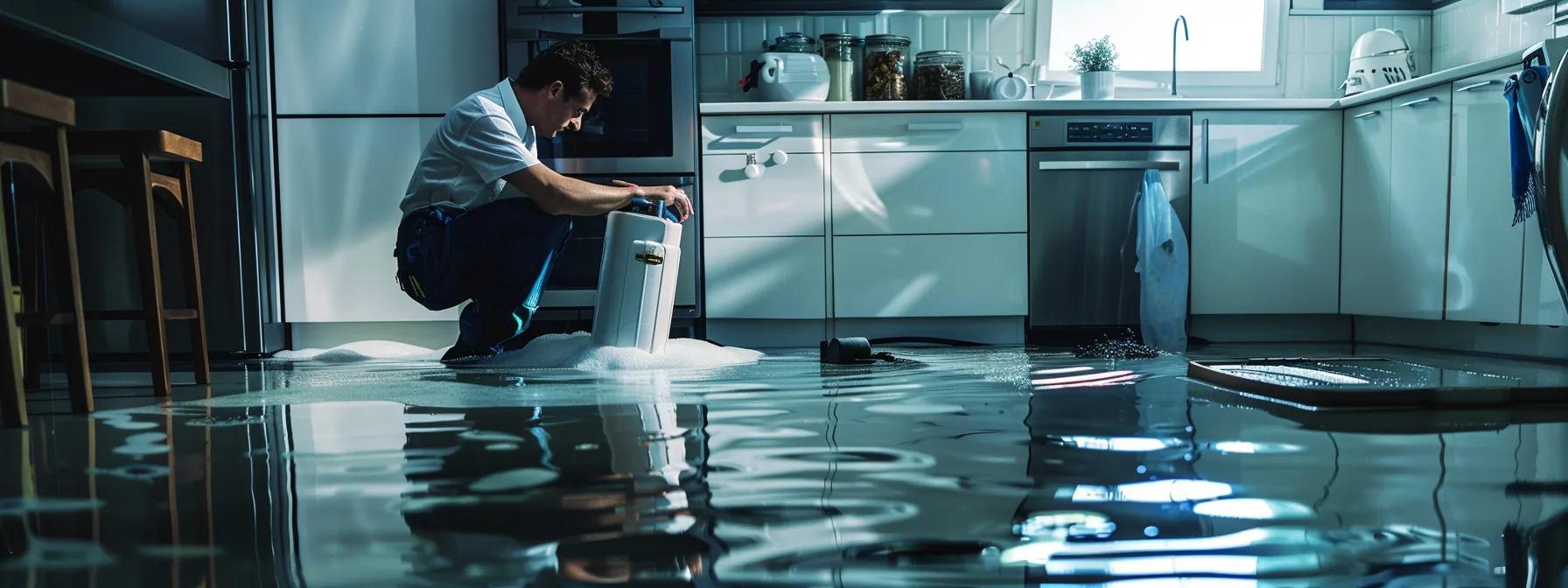
Prevention is the most effective strategy to avoid recurring kitchen water damage. Regular inspections, maintenance, and the installation of modern detection systems create a proactive shield against leaks and water-related incidents. By intervening before issues become severe, homeowners can protect their kitchens and reduce repair costs. This section provides detailed guidance on preventative measures, including routine plumbing inspections, the importance of leak detection devices, and how proper appliance maintenance plays a critical role in sustaining the integrity of kitchen structures.
Regular Inspection of Plumbing and Appliances
Routine inspections are the first line of defense against kitchen water damage. Homeowners should periodically check plumbing connections, hose integrity, and appliance conditions around the kitchen area. This includes examining under-sink pipes for any signs of corrosion or moisture, testing the tightness of faucets, and ensuring that appliances such as dishwashers and refrigerators are operating without leaks. Regular professional maintenance, such as annual inspections by certified plumbers, can help spot early signs of wear that might escalate into major leaks. Investing a small amount in preventive maintenance is far cheaper than facing extensive water damage restoration, especially when insurance claims might be contested due to negligence.
Installing Water Leak Detection Systems
Water leak detection systems are increasingly popular as a smart investment for modern homeowners. These systems utilize sensors strategically placed near high-risk areas like under sinks, behind dishwashers, or near water heaters to monitor moisture levels continuously. When an abnormal increase in moisture is detected, these systems alert homeowners immediately via mobile apps or alarms. Early detection significantly minimizes potential water damage by allowing swift corrective action before substantial structural damage occurs. In homes where water damage has previously occurred, installing such systems provides an added layer of security against repeat incidents. Advanced models even integrate with smart home systems, linking to automatic shut-off valves that cut water supply instantly when leakage is detected.
Maintaining Appliance Hoses and Connections
Maintenance of appliance connections, especially those involving water and drainage, is essential for long-term prevention. Regular replacement of brittle or worn-out hoses ensures that connections remain secure and leak-free. For dishwashers, refrigerators with ice makers, and washing machines, checking for signs of wear, such as cracks or bulges in hoses, should be part of every maintenance routine. It is equally important to ensure that hose clamps and connectors are tightened properly to prevent accidental disconnections or water seepage. Homeowners can also maintain appliance performance by using manufacturer-recommended detergents and avoiding overloading the unit, which may contribute to stress on the water-carrying components.
Understanding Your Homeowners Insurance Coverage for Water Damage
Not all water damage incidents are covered under standard homeowners insurance policies. Homeowners should be well-informed about the specific terms of their policies, particularly regarding water damage restoration and the limitations of coverage due to neglect or gradual deterioration. Reading the policy document thoroughly and speaking with an insurance representative can uncover any exclusions or additional riders necessary to secure comprehensive coverage. Proactive measures, such as installing leak detection devices and conducting regular maintenance, may also positively impact insurance premiums and ensure adequate mitigation of potential losses. Understanding the good-faith obligations required by the policy can protect homeowners from long-term liabilities and promote a rapid claims process should incidents occur.
Knowing When to Call Professionals for Kitchen Water Leak Repair
Finally, recognizing the appropriate time to seek professional assistance is crucial in preventing minor leaks from escalating. While small issues such as minor drips or slow leaks might be manageable with DIY repair techniques, persistent or severe problems require the expertise and equipment of certified professionals. Contractors specializing in water damage restoration can conduct comprehensive evaluations, perform effective repairs, and restore the area to its safe condition. Professional intervention also ensures adherence to local building codes and proper remediation of any hazardous materials such as mold. Homeowners should not hesitate to contact professionals if there is any uncertainty regarding the extent of the damage or the effectiveness of initial repair attempts.
Key Takeaways: – Regular inspections prevent unseen plumbing and appliance issues from developing into major repairs. – Water leak detection systems can provide early warnings and minimize potential damage. – Maintenance of appliance hoses and connections is key to preventing leaks. – A clear understanding of homeowners insurance coverage can aid in prompt claims. – Professional services are essential for diagnosing and repairing complex water damage issues.
Final Thoughts
Restoring a kitchen after water damage requires immediate action, systematic repair, and proactive prevention efforts. This article has detailed common sources of kitchen water incidents, emergency cleanup procedures, repair and remediation processes, and key preventative measures. Homeowners who invest in regular inspections, maintenance, and state-of-the-art detection systems can significantly reduce the risk of future water damage. Timely professional intervention not only safeguards property but also ensures that health hazards like mold are promptly addressed.
Frequently Asked Questions
Q: What are the first steps to take when water damage occurs in a kitchen? A: The initial steps include shutting off the main water supply and electrical circuits to prevent further damage or hazards. Next, remove standing water using vacuum or mopping methods and document the damage for insurance purposes.
Q: How can regular inspections help prevent kitchen water damage? A: Regular inspections help identify early signs of leaks, corrosion, and wear in plumbing and appliances. This proactive approach allows for timely repairs that can stop minor issues from escalating into severe water damage incidents.
Q: What role do water leak detection systems play in prevention? A: These systems use sensors placed near vulnerable areas to detect abnormal moisture levels, alerting homeowners immediately. Some models automatically shut off the water supply, significantly mitigating potential damage and ensuring prompt corrective action.
Q: When should professional repair services be called for a dishwasher leak? A: If the leak persists despite minor repairs or if there is evidence of extensive water damage to cabinetry and flooring, professional services should be engaged. Professionals have the necessary tools and expertise to address complex internal leaks and prevent further damage.
Q: How important is it to understand your homeowners insurance coverage for water damage? A: It is crucial, as policies may or may not cover gradual damage or neglect-related issues. Knowing your coverage details helps in adequately preparing for incidents and ensuring that proper maintenance measures are followed to secure insurance claims.


